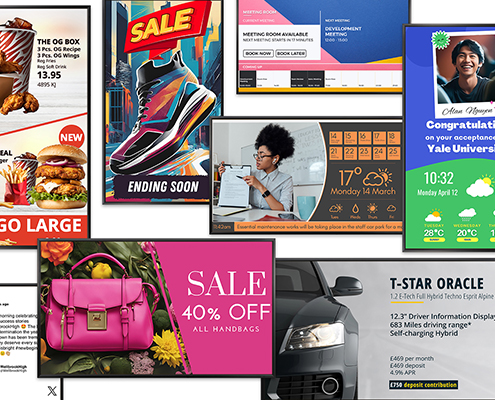Digital Signage is key to the success of any digital communications strategy, but what do you need to know to make sure that it works and fulfils its potential? If you’re about to roll out Digital Signage for the first time, or simply want to review and re-assess how you handle an existing Digital Signage network, then read on for some expert industry tips on what to do, and crucially, what NOT to do! Skip the trial-and-error phase and find out how you can avoid wasting time, money and resource.
1. Content plan
If you forget everything else, never forget this – it’s the content experience you want to create that should dictate your Digital Signage strategy. Every decision about the hardware and software you use, where you install your displays and what audiovisual features you need will all be determined by what exactly you want to achieve with your Digital Signage. Losing sight of why you required Digital Signage in the first place is a sure-fire way to fail. Think about what you want to say, to whom, and what your messaging should look like. Ask yourself what you need to create the experience you want.
2. Partner solutions
Digital Signage is composed of many different, but equally important technological parts. You need good screens and/or media players, along with equally impressive – and compatible – Digital Signage software, including a content management system (CMS) to arrange, manage and schedule your messaging. To create the ideal Digital Signage solution for the kind of content you want to promote, you need the right mix of technologies, so make sure you reason and research before you commit to investing in any equipment.
Frank Pisano, CEO of Bluefin, a leading manufacturer of custom digital display signage, stresses the importance of understanding the Digital Signage “ecosystem”, and that “knowledge is power”. Every technology provider has its own niche knowledge, and expertise. The best of these companies will be able to give you some general advice, but for an expert overview of the entire solution, resellers are best placed to offer the most in-depth and impartial direction. Think of resellers as tech guides – experienced experts, who can explain challenges, and hook you up with the equipment you really need.
You just need to specify exactly what viewer experience you want to achieve and ask how the installation environment might help or hinder this. Think about whether you want the experience to be interactive, and if you need big or smaller screens. Will the messaging you plan to feature on-screen be visible in the lighting conditions you have? Who will be responsible for generating the content? Do you have the scope, resource and capacity to achieve what you want? These are the kind of questions resellers can help you answer.
The companies and technologies they recommend will be based purely on what you need to fulfil your communication objectives. Companies like Bluefin are, for instance, great if you would like to overcome specific challenges, as they enable you to create customised Digital Signage to suit different environments. You might, for example, need extra air ventilation for Digital Signage that you install in particularly hot or humid spaces, such as those sometimes found in factories or catering venues.
3. It’s all about the timing
Like everything else in life, timing matters. As Pisano highlights, not all the technologies required for a specific solution are likely to be ready at the same time, so it’s important to factor in availability in advance. If, for instance, you need something bespoke for your hardware, like a stretch screen cut to size, then make sure you understand how this will impact your Digital Signage launch date.
4. Preparation
Preparation is key for Digital Signage. It’s a medium that can deliver a quick and lucrative return on investment, but only if you have done all the necessary prep work in advance. The secret is to test, and validate your Digital Signage plan, and pre-empt any potential issues.
Sometimes, the companies you work with can help set up and test your proofs of concept (POC). Such testing enables you to see the solution you envisioned in action, so you can iron out any issues, before you go live. This is also the perfect time to run A/B testing, and confirm what content works, what doesn’t, simply by running it on-screen for a private, hand-picked audience.
5. Future-proof your solution
What works for you today might not work for you tomorrow. Technology is moving forward at breakneck speed, and everyone needs to keep up, or miss out. When you’re researching software options, look out for those that are compatible with a range of globally available and well-known hardware brands. This will enable you to swap in new hardware products, as and when you need to, without having to replace the entire solution.
Don’t forget that you also need to build a solution that allows for growth. As your business grows, so too will your communication needs, whether this be for additional employees on different floors and in different buildings, or for customers in more venues. Develop a “land and expand” strategy with technology, and content management systems that make it easy to scale up. Cloud-based CMS platforms are ideal, enabling you to add screens and media players to your network, as and when required.
Another key to future-proofing your solution is making sure that the hardware and software companies you work with offer around-the-clock customer support. Even if you have the best technologies, something, somewhere will eventually go wrong, and it’s during these times that you’ll need quick support to minimise any Digital Signage downtime.
Provided you follow a few key steps to adequately prepare your network, Digital Signage can transform your communications outcomes. For more tips on how to avoid some common mistakes, tune into our latest Digital Signage Explored episode here with special guest and industry veteran, Frank Pisano, Bluefin CEO.





You must be logged in to post a comment.